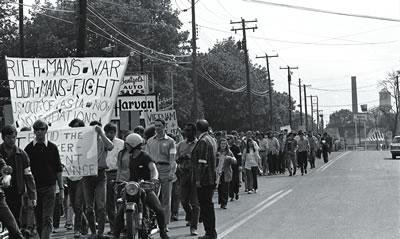Glimpses of Our Past
Glimpses of Our Past

Protesters marching through Carlisle.
by Jim Gerencser '93
“Plans for the march past the War College are progressing extremely well. The spirit of the march remains unchanged—the march will be non-violent.”
—The Dickinsonian, May 8, 1970
During a public address to the nation on April 30, 1970, President Richard Nixon announced that U.S. and South Vietnamese military incursions into Cambodia had commenced. Just a few days later, four students at Kent State University in Ohio were killed by National Guard troops. Later that evening, following a year of review and debate, the faculty of Dickinson College voted to retain the ROTC program but to end academic credit for its activities.
President Howard “Bud” Rubendall ’31 was alerted to the proceedings, and he arrived shortly after 11:30 in an attempt to calm the situation. He urged the students to reconsider a night march, arguing that it would be more prudent to allow time to plan the march appropriately and to avoid further escalating the existing tensions. The students accepted his suggestion and decided to hold the march later that week, on Friday, May 8—the 25th anniversary of V-E Day. They also voted to launch a general strike on the campus, which would be reconsidered after two days.
Throughout the week, students obtained the necessary permit for the march, prepared the route and made other appropriate plans. In a general referendum held on Wednesday, students voted 767 to 530 in favor of allowing ROTC to remain on campus. They also voted overwhelmingly to continue the strike.
During the march back to campus, about 200 students broke off and sat down just inside the War College entrance, blocking the road in an act of civil disobedience. An officer suggested a dialogue, and students returned to the athletic field, where several discussion groups with War College officials formed. At 9:30 p.m. the discussions ended and the last of the protesters returned to the Dickinson campus. As reported in The Dickinsonian the following week, a War College spokesman had remarked on the incident, “We are grateful that no violence occurred.”
Published July 1, 2012